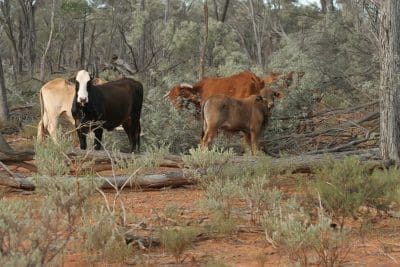 Queensland landholders say fine print underpinning tough new tree clearing laws contradicts State Government assurances that clearing of trees to ‘thin’ thickened vegetation for grazing will still be permitted.
Queensland landholders say fine print underpinning tough new tree clearing laws contradicts State Government assurances that clearing of trees to ‘thin’ thickened vegetation for grazing will still be permitted.
Under previous legislation landolders were able to use self-assessable codes to undertake thinning activities to managed thickened vegetation.
Under new legislation passed by Queensland Parliament on May 3, landholders are now required to make a development application to the Queensland Government and receive approval before thickened vegetation can be managed.
Despite this change the Queensland Government has made public assurances that landholders can still conduct thinning in Category C and Category R areas.
Regulation codes supporting the new legislation were published by the DNRME last week, including this “Relevant Purpose Determination Application Form”.
While landholders have been told they can apply to thin thickened vegetation, fine print on page seven of the document states that the “The VMA does not permit clearing for the purpose of grazing.”
It defines ‘managing thickened vegetation’ to mean the “selective clearing of vegetation at a locality (that does not include clearing using a chain or cable linked between two tractors, bulldozers or other traction vehicles): a. to restore a regional ecosystem to the floristic composition and range of densities typical of the regional ecosystem in the bioregion in which it is located; and b. to maintain ecological processes and prevent loss of biodiversity.”
Many have taken to social media to express their concern at the contents of the fine print.
In a post on Facebook rural group Property Rights Australia said that despite Government assurances that thickening woodland would still be able to thinned, the Government had “in a sneaky move to all intents and purposes stopped it”.
Quoting former long term Queensland Government scientist Dr Bill Burrows, PRA said there are about 60 million hectares of grazed woodlands on rural properties in Queensland today, and all relevant codes accompanying the latest legislation note that most of these woodlands are “thickening” – ie increasing in plant number, plant size, stem basal area, and canopy cover. The evidence of this from multiple sources and monitoring techniques was “overwhelming”.
The relationship between woody plant stem basal area and potential pasture production was commonly regarded as a “negative exponential relationship” Dr Burrows said. “This means that even a small stem basal area has a major depressing effect on both the underlying pasture and the animal productivity supported by it”.
Queensland’s grazed woodlands currently carry about of 2.1 million head of cattle or 20 pc of the state’s total livestock numbers. Without the ability to effectively manage woodland thickening, this carrying capacity would eventually be lost.
“It would appear that grazing of livestock is no longer a valued industry which provides revenue and contributes to the prosperity of the state,” PRA said.
“The Queensland cattle industry has a farm gate value of about $7 billion annually. Beef is the state’s largest export and our processors export about $6 billion worth of product (beef and co-product) annually. Jobs in the Queensland processing sector number about 18,000.
“We, the farmer/grazier landowners, are expected to be the providers of free ecosystem services, the unpaid and unappreciated guardians of biodiversity and whatever other eco-responsibilities which can be foisted upon us. If we can manage to eke out a living while providing these free services then so far at least, we will be tolerated.”
“I think that those of us who are landowners got the message loud and clear that this government does not support agriculture and in particular it is not fond of cattle grazing.”
Asked to clarify the statement that the’ VMA does not permit clearing for the purpose of grazing’, a spokesperson for the Department of Natural Resources, Mines and Energy said in a statement to Beef Central that had been the case since 2004.
“The thinning of remnant vegetation (now called managing thickened vegetation) for the purpose of grazing is not permitted under vegetation management laws. This has not changed since 2004,” the statement said.
“Managing thickened remnant vegetation under the vegetation management laws has only been permitted to restore forests or ecosystems that have unnaturally overgrown.
“Queensland’s landholders can continue to clear for the purpose of grazing in Category X areas.
We recommend landholders call 13 VEG (13 58 34) for information.”
